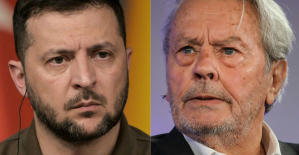Marfa, Texas: The decisive sentence falls on the first evening. "The town is so small," says one newcomer, "that everyone here thinks it's the center of the world." Other residents compare Marfa to an island, although water is scarce here and it rarely rains. Even by Texas standards, the town of 1,700 is isolated.
Big Bend, named after the loop that the Rio Grande River makes in far southwest Texas, is one of the emptiest parts of the United States and less than a hundred kilometers from Mexico. Around 1700, Europeans from the then still colonial Spanish south came to the area for the first time and built a number of forts.
The town of Marfa is significantly younger and owes its existence to the railway line built in the late 19th century, which relied on regular water stops. To this day, kilometers of freight trains whistle loudly through the town, and many other things are reminiscent of a film set.
'No Country For Old Men' was filmed in the area and you can still stay in Marfa at the Hotel Paisano, where James Dean stayed in 1956 during his last film 'Giant'. It is said that co-star Elizabeth Taylor flew in from El Paso for the shoot, because Marfa was still a dugout with no glamour.
The next difficult star should change that. His name was Donald Judd and he stayed. The minimal art pioneer fled the hustle and bustle of New York in the 1970s and installed steel and concrete art in former army buildings outside the city, which was particularly effective in the emptiness and vastness of the landscape.
In addition to this site, which is now managed by the Chinati Foundation, you can also visit the Judd estate itself. "The Block" is a walled collection of airy halls where Judd placed his own art, uncomfortable chairs, and surprisingly short daybeds. It's hard to believe that two children are said to have grown up in the spartan interior.
Donald Judd, who died in 1994, was not particularly popular with the Marfanians, but they avoided each other, as is customary here. With Judd began what continues to this day: Marfa's art career. More and more creative people followed him. In 2005, the artist duo built Elmgreen
"Prada Marfa" is a backdrop with no real shopping facilities, a practical joke as a sculpture, and an apt analysis of today's conditions. Because the Prada brand stands for art-loving luxury from Europe and that seems pleasantly out of place in the staunchly republican West Texas.
Today, Marfa is a Western town and an art Mecca at the same time. There is only one traffic light here, but all the more galleries, design and furniture shops, a radio station and a really good art gallery with the "Ballroom Marfa". And now also a major international gallery.
After three branches in Berlin, one in Paris and one in London, the German art dealer Max Hetzler has had a foothold in Marfa since this spring. Albert Oehlen, who has been represented by Hetzler for decades, is currently showing sculptures and drawings there, and artists from the gallery are to be able to work for a few months in a studio building next door – Grace Weaver, a New York painter, will be the first.
But if you want to visit Hetzler Marfa and don't have a private jet available, then it's a three-hour drive from the nearest airport in El Paso, nine from Houston, and fifteen from Los Angeles. But is isolation really a disadvantage?
Not really, the art world has a different geography. With every mile under the huge sky, with every steppe runner on the interstate highway, the hustle and bustle of the big city and the airports falls away from you. Max Hetzler is convinced that anyone who comes to Marfa is aware of this. But that doesn't mean that the place attracts the crowds.
Sometimes, a gallery employee reveals, no visitors appear in the bright rooms that have been built outside the town center for days, and then suddenly dozens in one day, like this weekend, when the gallery invited collectors, artists and friends Has.
The artists Christopher Wool and Charline von Heyl live around the corner anyway, and when there are enough people in town, suddenly there is something going on everywhere. The curator of the Judd Foundation projects video art onto a barn from a pick-up truck. Parisian designers, collecting tech investors from Los Angeles and musician Kim Gordon gather around a fire bowl.
It is an old utopia to be able to concentrate entirely on art in front of a spectacular natural backdrop, without having to do without high culture. Marfa thrives on being a successful, albeit precarious, amalgam. There are the bookstores and boutiques and the little hidden cafes with the screen doors, behind which you can sit on rickety second-hand furniture and consume $12 toast and art magazines from London. But if you're unlucky, there's nowhere to get a decent coffee at four o'clock in the afternoon, and the restaurant just shuts down.
The increasingly unpredictable opening times are a running gag in Marfa. Since the pandemic, one hears, it has become even more difficult to maintain the infrastructure, because the number of people who can make a living from art and the like is limited. But at least there is an infrastructure. Like the Crowley Theater where Albert Oehlen is showing his film The Painter.
Based on an idea by the artist and staged by Oliver Hirschbiegel (“Downfall”), Ben Becker strays as a star painter through Oehlen’s real Swiss studio, roars, drips and spills, throws himself on the floor in tears and commands the assistant around. Some American viewers are shocked. Is he serious?
no The film is not a portrait, explains Oehlen afterwards. Filming him painting isn't going to do much. After all, his work mainly consists of sitting on the sofa and looking at what he has done on the screen and then thinking about the next steps. Ben Becker, the stage pig, understands that reality isn't full-length.
He portrays Oehlen as a suffering genius who rattles off all sorts of sottis about the importance of smearing, the pitfalls of the color yellow and the overrated Cézanne. It is the precarious balance between lustfully acted out artist clichés and the real challenge of making a good picture out of a blank canvas that makes “The Painter”, previously only shown at festivals, such an experience. In March 2023 it will finally come to the cinema.

 Sydney: Assyrian bishop stabbed, conservative TikToker outspoken on Islam
Sydney: Assyrian bishop stabbed, conservative TikToker outspoken on Islam Torrential rains in Dubai: “The event is so intense that we cannot find analogues in our databases”
Torrential rains in Dubai: “The event is so intense that we cannot find analogues in our databases” Rishi Sunak wants a tobacco-free UK
Rishi Sunak wants a tobacco-free UK In Africa, the number of millionaires will boom over the next ten years
In Africa, the number of millionaires will boom over the next ten years Can relaxation, sophrology and meditation help with insomnia?
Can relaxation, sophrology and meditation help with insomnia? WHO concerned about spread of H5N1 avian flu to new species, including humans
WHO concerned about spread of H5N1 avian flu to new species, including humans New generation mosquito nets prove much more effective against malaria
New generation mosquito nets prove much more effective against malaria Covid-19: everything you need to know about the new vaccination campaign which is starting
Covid-19: everything you need to know about the new vaccination campaign which is starting For the Olympics, SNCF is developing an instant translation application
For the Olympics, SNCF is developing an instant translation application La Poste deploys mobile post office trucks in 5 rural departments
La Poste deploys mobile post office trucks in 5 rural departments Meta accelerates into generative artificial intelligence with Llama 3
Meta accelerates into generative artificial intelligence with Llama 3 In China, Apple forced to withdraw WhatsApp and Threads applications at the request of the authorities
In China, Apple forced to withdraw WhatsApp and Threads applications at the request of the authorities The main facade of the old Copenhagen Stock Exchange collapsed, two days after the fire started
The main facade of the old Copenhagen Stock Exchange collapsed, two days after the fire started Alain Delon decorated by Ukraine for his support in the conflict against Russia
Alain Delon decorated by Ukraine for his support in the conflict against Russia Who’s Who launches the first edition of its literary prize
Who’s Who launches the first edition of its literary prize Sylvain Amic appointed to the Musée d’Orsay to replace Christophe Leribault
Sylvain Amic appointed to the Musée d’Orsay to replace Christophe Leribault Skoda Kodiaq 2024: a 'beast' plug-in hybrid SUV
Skoda Kodiaq 2024: a 'beast' plug-in hybrid SUV Tesla launches a new Model Y with 600 km of autonomy at a "more accessible price"
Tesla launches a new Model Y with 600 km of autonomy at a "more accessible price" The 10 best-selling cars in March 2024 in Spain: sales fall due to Easter
The 10 best-selling cars in March 2024 in Spain: sales fall due to Easter A private jet company buys more than 100 flying cars
A private jet company buys more than 100 flying cars This is how housing prices have changed in Spain in the last decade
This is how housing prices have changed in Spain in the last decade The home mortgage firm drops 10% in January and interest soars to 3.46%
The home mortgage firm drops 10% in January and interest soars to 3.46% The jewel of the Rocío de Nagüeles urbanization: a dream villa in Marbella
The jewel of the Rocío de Nagüeles urbanization: a dream villa in Marbella Rental prices grow by 7.3% in February: where does it go up and where does it go down?
Rental prices grow by 7.3% in February: where does it go up and where does it go down? With the promise of a “real burst of authority”, Gabriel Attal provokes the ire of the opposition
With the promise of a “real burst of authority”, Gabriel Attal provokes the ire of the opposition Europeans: the schedule of debates to follow between now and June 9
Europeans: the schedule of debates to follow between now and June 9 Europeans: “In France, there is a left and there is a right,” assures Bellamy
Europeans: “In France, there is a left and there is a right,” assures Bellamy During the night of the economy, the right points out the budgetary flaws of the macronie
During the night of the economy, the right points out the budgetary flaws of the macronie These French cities that will boycott the World Cup in Qatar
These French cities that will boycott the World Cup in Qatar Europa League: “We dream of everything,” says Jean-Louis Gasset
Europa League: “We dream of everything,” says Jean-Louis Gasset Europa League: “Trouble playing our football,” admits Benfica coach
Europa League: “Trouble playing our football,” admits Benfica coach Europa League Conference: “Martinez eats all your deaths”, Obraniak’s breakdown after the elimination of Lille
Europa League Conference: “Martinez eats all your deaths”, Obraniak’s breakdown after the elimination of Lille Premier League: “It’s a team that is transforming into the Champions League”, Casemiro returned to Real’s qualification
Premier League: “It’s a team that is transforming into the Champions League”, Casemiro returned to Real’s qualification


















